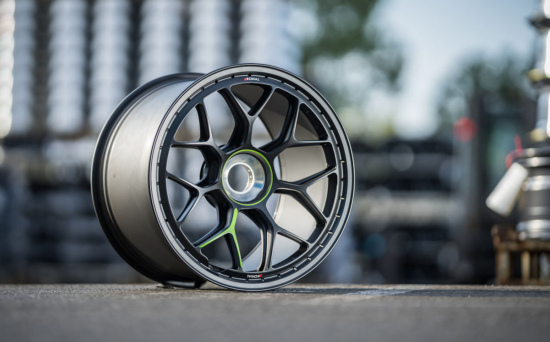Ronal’s monobloc wheel for the Lamborghini SC63
 This racing wheel will be worn by the Lamborghini SC63 race car participating in next year’s WEC & ISMA (Photo: Ronal)
This racing wheel will be worn by the Lamborghini SC63 race car participating in next year’s WEC & ISMA (Photo: Ronal)
Following on from the July 2023 announcement of its technical partnership with Lamborghini Squadra Corse to develop motorsport wheels for the Lamborghini SC63 race car that will participate in the FIA World Endurance Championship and other series from 2024, Ronal Group has shared further details about the monobloc wheels it is developing for the LMDh prototype.
The light alloy wheel specialist is undertaking the entire development in-house, including turning, milling and coating processes. It is performing design, machining, CMM measurement and final inspection at the App-Tech plant in Mestrino, Italy and carrying out painting, Pad Printing and all testing at the Ronal plant in Landau, Germany.
The one-piece aluminium forged wheels that Ronal is developing for Lamborghini Squadra Corse include an aero ring. Ronal states that this combination of technology and aesthetics and provides aerodynamic efficiency. It draws particular attention to the small circumferential holes on the aero ring that, in addition to water, dust and dirt, allow hot air generated by the brakes to pass through. In this way, the holes cool the brakes while improving aerodynamic efficiency in the area around and downstream from the wheels.

Small circumferential holes on the aero ring allow hot air generated by the brakes to pass through (Photo: Ronal)
Coloured visual identifiers
“It was a significant design and production feasibility challenge to obtain a very lightweight and functional aero ring fully integrated within a single-piece monobloc wheel as regulations stipulate that the wheel must be a single piece of metal. This was achievable only thanks to the use of five-axis milling machines and the expertise of the development team,” says Matteo Melara, head of R&D at App-Tech and responsible for the wheel’s design.
Each front wheel is 12.5″x18″ and weighs 8.75 kg, the rear wheels 14″x18″ and 9.25 kg. The weight is the minimum that technical regulations permit. The wheels are matt black and are equipped with a centre lock surrounded by a coloured annulus whose main function is to provide mechanics with a visual identifier for quickly locating the centre lock during pit stops.
The front wheels are marked with a green ‘Y’ and the rear wheels with a red ‘Y’ on the spoke adjacent to the inflation valve, again to serve as a reference to mechanics tasked with speedily adjusting tyre pressures. Ronal chose green and red to represent the colours of the Italian flag.
The hexagon and the Y are stylistic elements that have characterised Lamborghini design since the very beginning. “The Ronal Group engineers have picked up this iconic style to create a tailor-made design to fit the customer’s wishes,” says Melara. “Behind the iconic Lamborghini design theme, we built an optimised structure to sustain performance at all the full load cases whilst achieving an optimum weight. The end product combines high-level performance, structure and style.”
Five-axis milling technique
Ronal utilised a range of different specific technologies and machines to construct the high-performance racing wheels. It flow-formed forged blanks and then passed these to machining/turning, first on a three-axis machine and then on a five-axis milling machine (special milling). It employed five-axis milling technology to achieve the optimal structural performance possible when undertaking aluminium forging. Compared to results gained from a standard casting process, five-axis technology allows the best ‘double T’ shape of the spoke to be obtained, minimising weight and increasing stiffness and load capability. The same is true of the aero ring, with the five-axis machine removing excess materials to obtain the optimum weight.
“The combination of these technologies – high mechanical characteristics and homogeneous material due to forging plus the geometrical optimisation thanks to milling – allows us to obtain the unique structural performance,” comments Melara.
Paint kept to a minimum
After completing all mechanical processes, Ronal applies an advanced lightweight coating using customised graphics. This coating improves aesthetics without compromising weight and durability and can also withstand heat from the brakes. A minute amount of paint covers the surface – only 100g per wheel, or around a third of the quantity typically applied. The top layer is a clear coat that protects the wheel against carbon powder staining due to brake wear and chipping by pebbles thrown up from the road.

After completing all mechanical processes, Ronal applies a lightweight coating that can withstand heat from the brakes (Photo: Ronal)
The rim is also compatible with anti-skid features that prevent rotation occurring between the wheel and tyre as a result of forces such as acceleration or braking. Its profile is thus different from that of standard wheels as it must withstand the maximum stresses of demanding race tracks.
As a final step, Ronal applies its logo and the aforementioned coloured visual identifiers using Pad Printing, an indirect pressure process involving the application of an elastic pad with different geometries to the surface of a wheel.





Comments